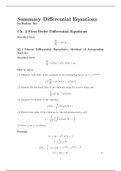Summary Differential Equations
by Ruben Tol
Ch. 2 First-Order Differential Equations
Standard form
dy
= f (t, y)
dx
§2.1 Linear Differential Equations; Method of Integrating
Factors
Standard form
dy
+ p(t)y = g(t), y(t0 ) = y0
dt
How to solve
R
p(t) dt
(1) Multiply both sides of the equation by the integrating factor µ(t) = e :
dy
µ(t) + µ(t)p(t)y = µ(t)g(t).
dt
(2) Rewrite the left-hand side of the equation using the reverse chain rule:
d
(µ(t)y) = µ(t)g(t).
dt
(3) Integrate both sides of the equation:
Z
µ(t)y = µ(t)g(t) dt + c.
(4) Divide both sides of the equation by the integrating factor µ(t):
�Z �
1
y= µ(t)g(t) dt + c .
µ(t)
(5) Solve y for t0 to obtain c.
Example
ty 0 + 2y = 4t2 , y(1) = 2
2
y 0 + y = 4t
t
2 R 2
p(t) = =⇒ µ(t) = e t dt = e2 ln |t| = t2
t
t2 y 0 + 2ty = 4t3 (1)
1
, d 2 �
t y = 4t3 (2)
dtZ
t2 y = 4t3 dt = t4 + c (3)
c
y = t2 + (4)
t2
c
y(1) = 2 =⇒ 2 = 12 + =⇒ c = 1 (5)
12
1
y = t2 +
t2
§2.2 Separable Differential Equations
Standard form
dy
N 0 (x, y) + M 0 (x, y) = 0, y(x0 ) = y0
dx
How to solve
(1) Try to rewrite the equation by rewriting M (x, y) to a function of only x and
N (x, y) to a function of only y, by pulling all functions of x to one side, and all
functions of y to the other side:
dy
N 0 (y)
= M 0 (x).
dx
(2) Write the equation in differential form:
N 0 (y) dy = M 0 (x) dx.
(3) Integrate both sides of the equation:
N (y) = M (x) + c.
(4) Solve y for t0 to obtain c.
Example
dy 3x2 + 4x + 2
= , y(0) = −1
dx 2(y − 1)
dy
2(y − 1) = 3x2 + 4x + 2 (1)
dx
2(y − 1) dy = (3x2 + 4x + 2) dx (2)
Z Z
2(y − 1) dy = 3x2 + 4x + 2 dx =⇒ y 2 − 2y = x3 + 2x2 + 2x + c (3)
(y − 1)2 = x3 + 2x2 + 2x + 1 + c
√
y = 1 ± x3 + 2x2 + 2x + 1 + c
√
y(0) = 1 =⇒ 1 = 1 ± 1 + c (4)
√ √
1 + c > 0 =⇒ −1 = 1 − 1 + c =⇒ c = 3
√
y = 1 − x3 + 2x2 + 2x + 4
2
,§2.4 Differences Between Linear and Nonlinear Differential
Equations
df
Let f (t, y) and dy be continuous in some rectangle α < t < β, γ < y < δ containing
the initial value (t0 , y0 ). Then, in some interval t0 − h < t < t0 + h ∈ [α, β] there is
a unique solution y = φ(t) to the initial value problem.
Example
Let’s take the example equation from §2.1,
ty 0 + 2y = 4t2 .
This equation has the solution
1
y = t2 + .
t2
This solution is only continuous on the interval −∞ < t < 0, 0 < t < ∞ (t 6= 0).
Now, if we take the initial condition to be y(1) = 2, the unique solution φ(t) lays
in the interval 0 < t < ∞, for t0 = 1 ∈ [0, ∞]. If we take the initial condition
to be y(−1) = 2, the unique solution φ(t) lays in the interval −∞ < t < 0, for
t0 = −1 ∈ [−∞, 0].
§2.5 Autonomous Differential Equations and Population Dy-
namics
Standard form
dy
= ry
dx
Here, r is called the rate of growth if r > 0, or the rate of decline if r < 0.
Solving for the initial condition y(0) = y0 yields
y = y0 ert .
A population growth can be modelled with this equation, where y0 equals the amount
of a species at t0 and r > 0, allowing this population to grow exponentially.
dy
�
To show this growth, we plot dx , y and indicate the direction of the growth using
arrows on the y-axis. This line is called the phase line. For this equation, the phase
line is
0 −→ ∞.
To account for the fact that the growth rate actually depends on the population, we
will rewrite this equation to
dy � y�
=r 1− y.
dt K
Here, r is the intrinsic growth rate, that is, the growth rate in the absence of any
limiting factor, and K is the saturation level, that is, the environmental carrying
capacity for the given species, both positive constants.
3
, dy
Solving this equation for dx = 0, when the population growth is stable, yields the
constant solutions y = φ1 (t) = 0 and y = φ2 (t) = K. These solutions are called the
equilibrium solutions, with 0 and K being called the critical points of the equation:
the function will eventually converge to y = φ2 (t) = K. φ1 (t) = 0 is called the
unstable equilibrium solution, meaning the population died out. y = φ2 (t) = K is
called the asymptotically stable solution, meaning the population will get closer and
closer to y = K:
y0 K
lim y(t) = = K.
x→∞ y0
The phase line for this equation contains the critical point K:
0 −→ K ←− ∞.
Now, let’s consider the following equation:
dy � y�
= −r 1 − y.
dt T
Here, T is the threshold level, also a positive constant.
dy
Solving this equation for dx = 0, when the population growth is stable, yields the
constant solutions y = φ1 (t) = 0 and y = φ2 (t) = T . Now, if 0 < y < T , then
dy
dt
< 0, implying the population dies out over time and approaches the solution
y = φ1 (t) = 0. On the other hand, if y > T , then dy
dt
< 0, implying the population
keeps growing exponentially, with y = φ2 (t) = T being the unstable equilibrium
solution.
This equation has the following phase line:
0 ←− T −→ ∞.
To get rid of any unbounded growth, the following equation is used:
dy � y �� y�
= −r 1 − 1− y.
dt T K
where r is a positive constant and 0 < T < K.
Again, solving for dy
dt
now yields three critical points: y = φ1 (t) = 0, y = φ2 (t) = T
and y = φ3 (t) = K. Now, if T < y < K, then dy dt
> 0, allowing growth. But, if y < T
dy
or y > K, dx < 0, decreasing the population size in those intervals. Consequently,
the equilibrium solutions y = φ1 (t) = 0 and y = φ3 (t) = K are asymptotically
stable, and the solution y = φ2 (t) = T is unstable. This equation creates the
following population growth:
If y > K, the population is too big to be sustained, and declines down towards the
asymptotically stable solutions y = φ3 (t) = K.
If y < T , the population is too small to be sustained, and declines down towards
the asymptotically stable solutions y = φ1 (t) = 0.
4
, If T < y < K, the population is big enough to grow, inclining towards the asymp-
totically stable solution y = φ3 (t) = K and away from the unstable equilibrium
solution y = φ2 (t) = T .
This yields the following phase line:
0 ←− T −→ K ←− ∞.
§2.6 Exact Differential Equations and Integrating Factors
Standard form
∂N (x, y) ∂M (x, y)
N (x, y)y 0 + M (x, y) = 0, where =
∂x ∂y
How to solve
(1) Define a function ψ(x, y) with the following property:
∂ψ ∂ψ
N (x, y) = , M (x, y) = .
∂y ∂x
(2) Rewrite the equation to
∂ψ ∂ψ dy
+ = 0.
∂x ∂y dx
(3) Rewrite the left-hand side of the equation using the chain rule:
d
ψ(x, y) = 0.
dx
(4) Integrate both sides of the equation:
ψ(x, y) = c.
Solutions of the equation are defined implicitly by ψ(x, y) = c.
Example
2x + y 2 + 2xyy 0 = 0
∂ψ ∂ψ
2x + y 2 = , 2xy = =⇒ ψ(x, y) = x2 + xy 2 (1)
∂x ∂y
∂ψ ∂ψ dy d d 2
+ = 0 =⇒ ψ(x, y) = 0 =⇒ (x + xy 2 ) = 0 (2,3)
∂x ∂y dx dx dx
ψ(x, y) = x2 + xy 2 = c (4)
5






